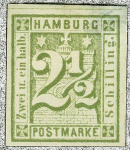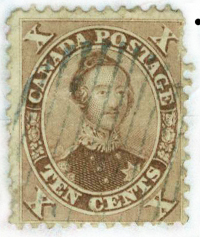
Discussion - Member to Member Sales - Research Center

Discussion - Member to Member Sales - Research Center

Dave

Login to Like
this post
It is a Danzig stamp issued in 1920, SG40b. Danzig was declared a Free City (Freie Stadt) by the Treaty of Versailles, 28th June 1919, and issued its own stamps from 1920 to 1939 when Germany took over. After the war it became Polish (Gdansk).
There are multiple types:
1. background in grey (issued Aug.20th 1920)
2. background in lilac (issued Nov. 1st 1920)
A. burele background with points upward toward the right
B. ditto with points downward towards the left
or "All values exist without burele background"
or "All except two with background double"
At a guess I'd say your stamp shows:
2. Lilac background
B. burele, points downward, and
background double
but I'm open to correction on that!

2 Members
like this post.
Login to Like.
SG40b?
Dave

Login to Like
this post
SG refers to Stanley Gibbons, one of the pre-eminent British catalogue publishers. Americans tend to use scott; Brits use SG
David

1 Member
likes this post.
Login to Like.
So, Dave, was my post useful - apart, that is, from "SG40b"? Did it give you the information you sought, which I presume you were unable to get from your Scott catalogue?
It would be nice to know.
By the way, I take it you are working from the simplest version of Scott; they are not commonly used over here (indeed I have never seen one), so I do not know what versions are available to you. The simplest version of Stanley Gibbons would have got you pretty close to "40b" (it does not distinguish between the lilac and the grey backgrounds).

1 Member
likes this post.
Login to Like.
Scott 26c
{image removed}
There is the "normal" Scott catalogue from which I lifted this information and then there is the Scott Classic Specialized, which runs to 1940 (1952 for British Commonwealth)
Jan-Simon
Note: I should have known better and realized that it was not allowed to post a scan out of the Scott catalogue. Those of you who have seen it, they now know what Scott has to say about this stamp. To everybody else: tough luck...

3 Members
like this post.
Login to Like.
What a strange proscription!
For those, then, who missed Jan's evidently illegal scan, the following. The normal Scott catalogue has much more detail than Stanley Gibbons Simplified, and almost as much as whatever SG now call their next step up, which in the 1970s was a three-volume "Europe" catalogue, and which may now be something like a one-volume "Part 7, Germany". The distinction lay only in SG's observation that "all values exist without burele background" and "all except two values have background double", which Scott omits to mention. Neither did Scott display the various overprints in Jan's scan, which SG does.
No-one has yet ratified my original answer to Dave's question, "What is it?". What do you think it is?

Login to Like
this post
My conclusion was that it is Scott #26c, which is the violet burelage with points down. Scott does not list double backgrounds, so this is as detailed as it gets.

Login to Like
this post
Yes, the burelage is double.

I have a normal copy in front of me to compare it with.

Login to Like
this post
I think it is Michel 42II/IV
i.e. Mi 42 (1¼ M on 3 pf with bright lilac grey burelage) II (with points down) /IV (with burelage doubled)
or
Netzunterdruck lebhaftlilagrau, mit doppeltem Netzunterdruck, beide Spitzen nach unten
I see Michel lists in the same set Mi 46I/II/IV, i.e. with double burelage, one pointing up and the other down.

Login to Like
this post
Well, it is all academic now, since Dave has left us (see other posts elsewhere on this website). I do wonder why he could not have done the homework himself, though (hence my initial enquiries about what catalogue he might have used). Perhaps there was more to the Master Sergeant's back-story than an outsider knew of.

Login to Like
this post
08:00:49pm
Ahhh - but for those of us who collect Danzig and Germany, you have helped us immensely! Thank you for the info.
Kelly

1 Member
likes this post.
Login to Like.
Guthrum
References
Your response dated 23 March 2015 at 045302AM Hours, & 23 March 2015 at 065419PM hours:
Guthrum, many thanks for your kind information.
I experienced a difficult computer problem when trying to update my profile. I asked StampoRama for help, but no one could help me.
I was very disappointed that I could not thank you for the information you provided, again, sorry it took so long to get back to you!
David Thompson

1 Member
likes this post.
Login to Like.
Thanks for that note, David. Is it appropriate to say, "Welcome back!"?
I think I was originally puzzled by what is or is not included in the catalogues people have to hand at any given time. Sometimes it seems strange when people ask for information which is readily available in one country and is clearly not in another. I suspect this applies especially to those who collect Whole World, where even an up-to-date set of the simplest catalogues runs into hundreds of pounds/dollars.

Login to Like
this post
"Is it appropriate to say, "Welcome back!"?"
Oh. Apparently not, if a post on another thread is to be believed. This is really all very confusing.

Login to Like
this post

re: What Is It?
It is a Danzig stamp issued in 1920, SG40b. Danzig was declared a Free City (Freie Stadt) by the Treaty of Versailles, 28th June 1919, and issued its own stamps from 1920 to 1939 when Germany took over. After the war it became Polish (Gdansk).
There are multiple types:
1. background in grey (issued Aug.20th 1920)
2. background in lilac (issued Nov. 1st 1920)
A. burele background with points upward toward the right
B. ditto with points downward towards the left
or "All values exist without burele background"
or "All except two with background double"
At a guess I'd say your stamp shows:
2. Lilac background
B. burele, points downward, and
background double
but I'm open to correction on that!

2 Members
like this post.
Login to Like.
Auctions
re: What Is It?
SG refers to Stanley Gibbons, one of the pre-eminent British catalogue publishers. Americans tend to use scott; Brits use SG
David

1 Member
likes this post.
Login to Like.

re: What Is It?
So, Dave, was my post useful - apart, that is, from "SG40b"? Did it give you the information you sought, which I presume you were unable to get from your Scott catalogue?
It would be nice to know.
By the way, I take it you are working from the simplest version of Scott; they are not commonly used over here (indeed I have never seen one), so I do not know what versions are available to you. The simplest version of Stanley Gibbons would have got you pretty close to "40b" (it does not distinguish between the lilac and the grey backgrounds).

1 Member
likes this post.
Login to Like.

Auctions - Approvals
re: What Is It?
Scott 26c
{image removed}
There is the "normal" Scott catalogue from which I lifted this information and then there is the Scott Classic Specialized, which runs to 1940 (1952 for British Commonwealth)
Jan-Simon
Note: I should have known better and realized that it was not allowed to post a scan out of the Scott catalogue. Those of you who have seen it, they now know what Scott has to say about this stamp. To everybody else: tough luck...

3 Members
like this post.
Login to Like.

re: What Is It?
What a strange proscription!
For those, then, who missed Jan's evidently illegal scan, the following. The normal Scott catalogue has much more detail than Stanley Gibbons Simplified, and almost as much as whatever SG now call their next step up, which in the 1970s was a three-volume "Europe" catalogue, and which may now be something like a one-volume "Part 7, Germany". The distinction lay only in SG's observation that "all values exist without burele background" and "all except two values have background double", which Scott omits to mention. Neither did Scott display the various overprints in Jan's scan, which SG does.
No-one has yet ratified my original answer to Dave's question, "What is it?". What do you think it is?

Login to Like
this post

Auctions - Approvals
re: What Is It?
My conclusion was that it is Scott #26c, which is the violet burelage with points down. Scott does not list double backgrounds, so this is as detailed as it gets.

Login to Like
this post

re: What Is It?
Yes, the burelage is double.

I have a normal copy in front of me to compare it with.

Login to Like
this post

re: What Is It?
I think it is Michel 42II/IV
i.e. Mi 42 (1¼ M on 3 pf with bright lilac grey burelage) II (with points down) /IV (with burelage doubled)
or
Netzunterdruck lebhaftlilagrau, mit doppeltem Netzunterdruck, beide Spitzen nach unten
I see Michel lists in the same set Mi 46I/II/IV, i.e. with double burelage, one pointing up and the other down.

Login to Like
this post

re: What Is It?
Well, it is all academic now, since Dave has left us (see other posts elsewhere on this website). I do wonder why he could not have done the homework himself, though (hence my initial enquiries about what catalogue he might have used). Perhaps there was more to the Master Sergeant's back-story than an outsider knew of.

Login to Like
this post
A Service Dog gives a person with a disability independence. Never approach, distract or pet a working dog, especially when (s)he is in harness. Never be afraid to ask questions to the handler (parent).
25 Mar 2015
08:00:49pm
re: What Is It?
Ahhh - but for those of us who collect Danzig and Germany, you have helped us immensely! Thank you for the info.
Kelly

1 Member
likes this post.
Login to Like.
12:36:40am
re: What Is It?
Guthrum
References
Your response dated 23 March 2015 at 045302AM Hours, & 23 March 2015 at 065419PM hours:
Guthrum, many thanks for your kind information.
I experienced a difficult computer problem when trying to update my profile. I asked StampoRama for help, but no one could help me.
I was very disappointed that I could not thank you for the information you provided, again, sorry it took so long to get back to you!
David Thompson

1 Member
likes this post.
Login to Like.

re: What Is It?
Thanks for that note, David. Is it appropriate to say, "Welcome back!"?
I think I was originally puzzled by what is or is not included in the catalogues people have to hand at any given time. Sometimes it seems strange when people ask for information which is readily available in one country and is clearly not in another. I suspect this applies especially to those who collect Whole World, where even an up-to-date set of the simplest catalogues runs into hundreds of pounds/dollars.

Login to Like
this post

re: What Is It?
"Is it appropriate to say, "Welcome back!"?"
Oh. Apparently not, if a post on another thread is to be believed. This is really all very confusing.

Login to Like
this post

